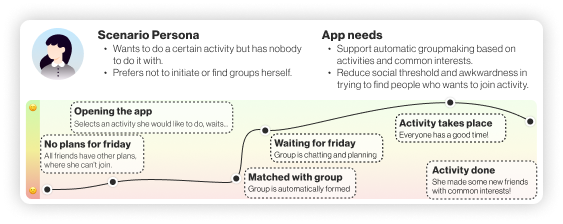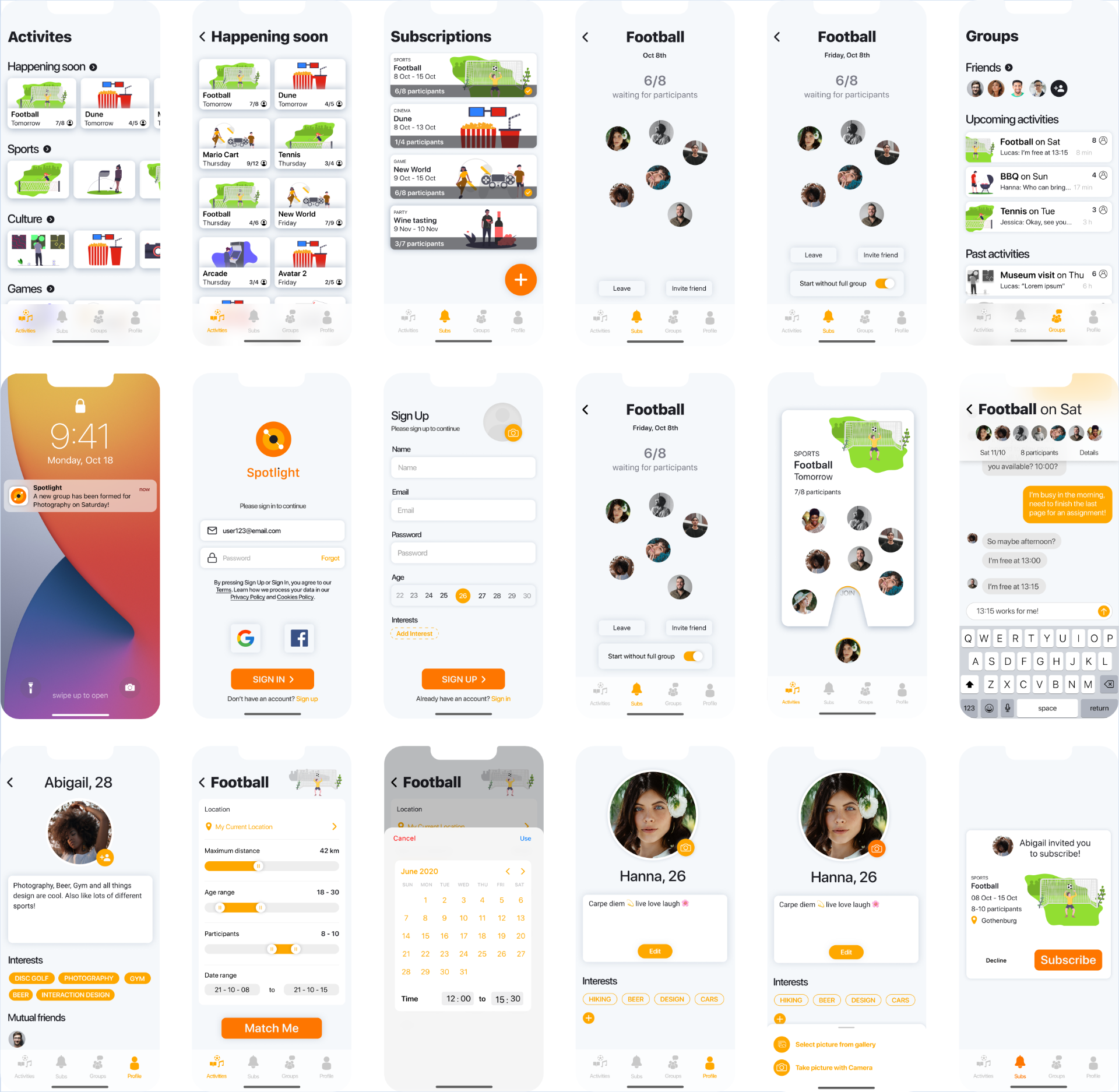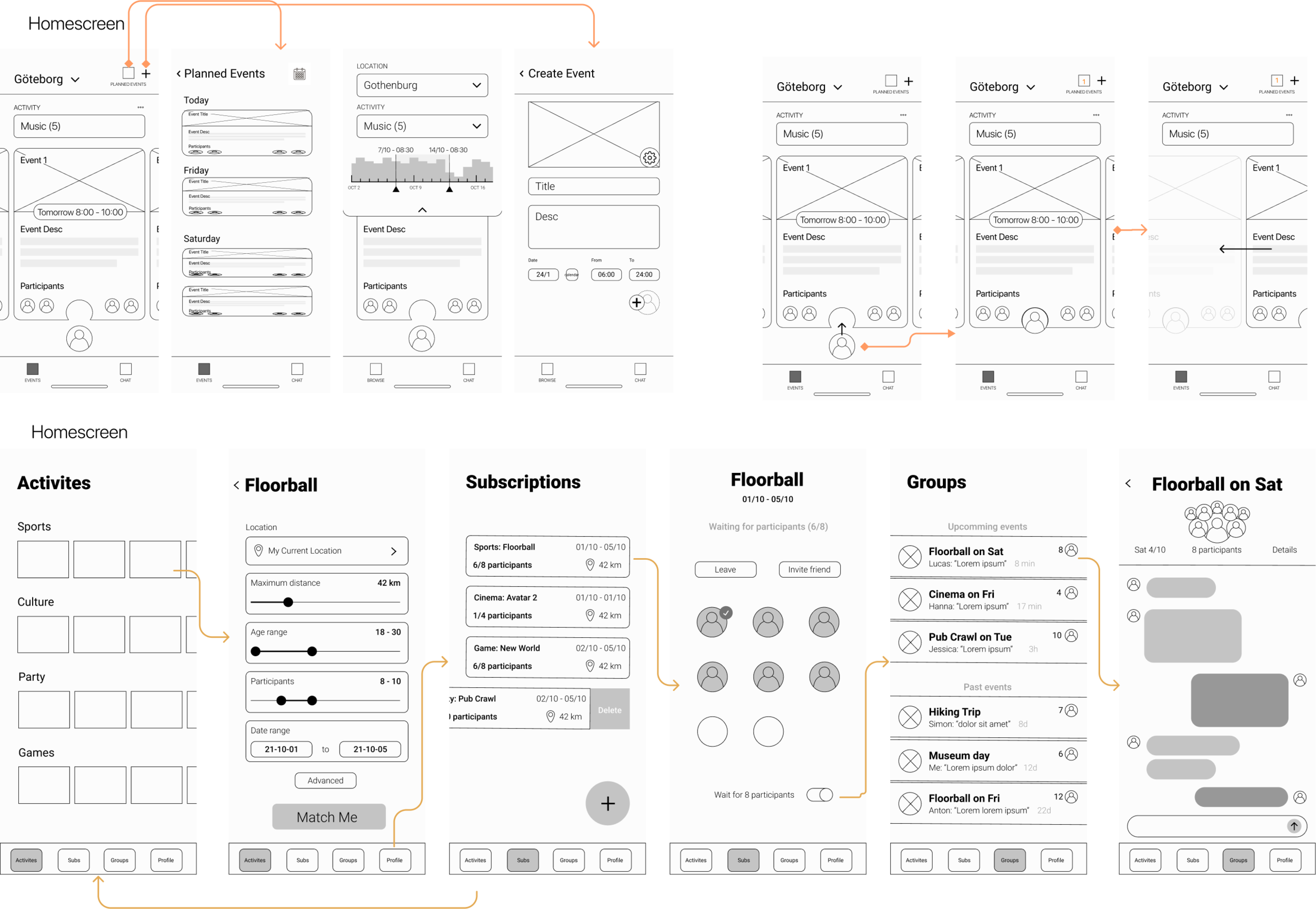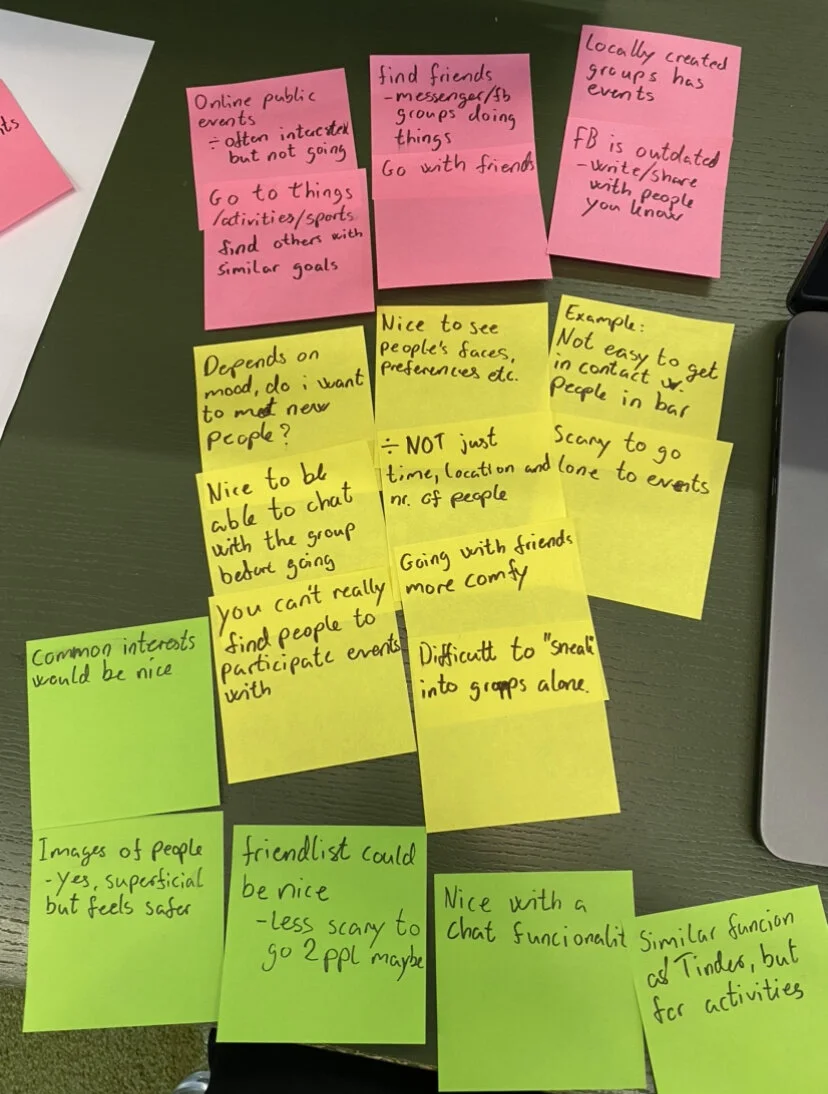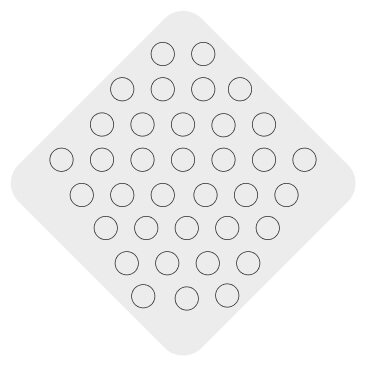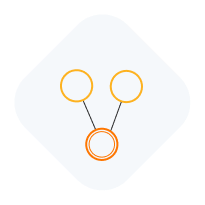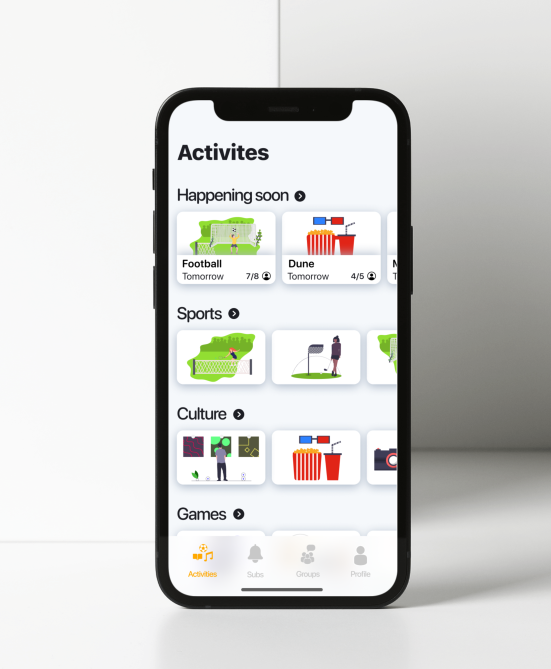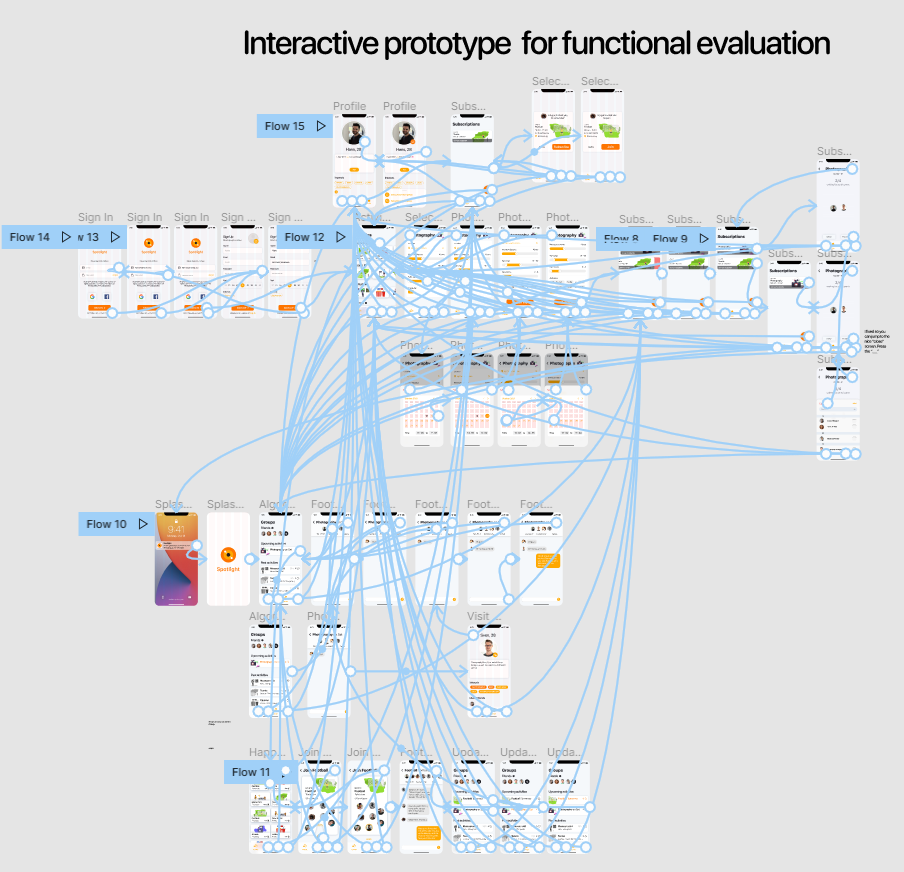Mobile Computing: Spotlight
Group project: Svend Gudbjart Geerthsen, with credits to Emmanuel Brorsson, Amos Cappellaro and Mattias Nilsson for their work in the project.
Length: 4 weeks, in fall 2021
Course: CLS055 - Mobile Computing & Implementation
Background
Supporting research and purpose: Tools to connect people are an important area in which technology can be a possible gamechanger in feelings of loneliness. Reports by SCB suggests that 14% of Swedes don’t have what they would describe as a close friend [5]. Furthermore, up to 300.000 Swedes, where a majority live alone, experience feelings of extreme loneliness and social isolation [6].
The area of this purpose could therefore be considered a way of initiating and mediating social connections through activities planned on a mobile platform. This platform would support finding like-minded people to do activities with, both for those who don’t have friends but also those who have friends but none with similar interests or preferred activities.
Target group: People who don’t have a close group of friends with similar interests need a way to find like-minded people to do activities with. An early focus group discussion (n=5 participants) showed that when participating in an activity with strangers, there is a strong preference for finding common ground prior to attending.
Our concept and goal: To account for these requirements, the projects goal was focused on creating a mobile application with preference-based matchmaking, a low barrier of entry regarding activities, and communication.
Loneliness is common, activities can be the string which connects people.
Competitor analysis showed that many current matchmaking apps are oriented towards:
Dating.
Exclusive-based groups.
Rating systems to increase or decrease matching.
Higher thresholds of entry.
Communication
Interact by moving your profile picture, chat, and a friend-list (typical, but highlighted in the focus group).
Preference-based matchmaking
The matchmaking builds on two pillars. Firstly, activity-specific preferences such as location, time and type. Secondly, individuals are also matched according to common interests, which are entered and updated by each user.
Low barrier of entry
Common interests create a shared ground for socialization when meeting up for the activity.
The Design
Overview
Collection of the screens used for evaluating
User journey map for the algorithmic direction
Mockup collection from the prototype
Wireflows of the chosen directions
Higher fidelity mockup-wireflows





The Process
Phases
1 2 3 4
Phase 1
Insights from focus group discussion
Upon picking a brief and creating a return brief, a focus group discussion were held and background research were conducted. The findings showed high threshold of entry and lacking tools for finding likeminded people.
Further, a brainstorming session was done to diverge and explore possibilities.
Phase 2
One of the three directions
The resulting ideas from the brainstorming-session were several, but three directions were decided and further defined using the 635-method.
To base these three directions more solidly on our target group and the insights from the focus group discussion, journey maps were created and later wireframes were made for all three. Two directions were decided upon by the end of this phase.
Phase 3
Brand Identity
One of the directions, “skill-based matchmaking” was removed. Groups should be formed on basis of personal preferences and interests, rather than wishes of performance and competition.
A brand-identity board was created on basis of a moodboard, to have a clear common ground regarding aspects such as values, typography, visuals and color.
Wireflows & Mockups
More in-depth wireflows were created for each of the remaining two directions and when a level of iteration had been done, they were further developed into mockups based off the brand identity.
In the end they were merged into a final prototype.
Phase 4
Final prototype
The final prototype is based on an algorithmic approach to matchmaking, which differentiated it from competitors and its affordances of matchmaking based on personal preferences and personalization.
This prototype was refined through several iterations, consistently conducting internal testing of everything from usability, understanding and coherrency. Several potential use-cases were considered and some were used as basis for refinements, giving a clearer vision of who this app is designed for.
This included: People lacking a preference of activity, possibility to include friends in activity matchmaking and joining “last minute” activities.
Result
Think aloud walk-through + Semi-structured interviews (n=3)
Part of the figma-file used for evaluating
One of the evaluation sessions.
Core strengths of the concept
A match-making feature based on preferences lower the threshold for entry and is helpful in temporary situations, such as when being new in a city.
An ability to select activity-specific preferences (such as time, location, etc.) is helpful for planning further ahead, but for the more spontaneous the "Happening Soon" would be sufficient.
Summary of insights from the evaluation
Activity-specific preferences
Supports long-term planning.
Allows flexibility of time.
User profiles involving common interests
Visible personalization, finding likeminded people.
Supports conversations.
Increases emphasis on socialization.
Preference-based matchmaking
Activity-specific preferences such as location, time, age and number of participants, together with being matched with people of similar interests is the main pillars of the algorithmic approach. Users see this as lowering the threshold.
Future improvements
Skill-level could be included for relevant activities.
Planning logistics could be improved.
Browsing and creating activities manually is highlighted as a wish.
Final notes
Allowing users to inspect common interests, biography, name, and picture of other participants might function as an ‘icebreaker’ for starting and facilitating ongoing interactions[1, 3], as well as, lead to conversations of higher quality [2], by involving more intimacy and trust [4]. Thus, making these affordances available for the user, Spotlight can support the initial purpose of the concept.
Spotlight can be argued to be a potential foundation for social interaction and connection, by supporting the matching of likeminded participants based on personal preferences in activities. The affordances given through visibility of personal interests can support finding common ground between participants and support the first steps in social connections.
Improvements are primarily wanted in terms of how big a part the automatic way of matching should be, the evaluators wished a more transparent approach that allows manual creation and browsing of events.
Spotlight, connecting people through preference-based activity matchmaking.
[1] Kytö, M., Hirskyj-Douglas, I. and McGookin, D., 2021, February. From Strangers to Friends: Augmenting Face-to-face Interactions with Faceted Digital Self-Presentations. In Augmented Humans Conference 2021 (pp. 192-203).
[2] Nguyen, T.T., Nguyen, D.T., Iqbal, S.T. and Ofek, E., 2015, April. The known stranger: Supporting conversations between strangers with personalized topic suggestions. In Proceedings of the 33rd Annual ACM Conference on Human Factors in Computing Systems (pp. 555-564).
[3] Olsson, T., Jarusriboonchai, P., Woźniak, P., Paasovaara, S., Väänänen, K. and Lucero, A., 2020. Technologies for enhancing collocated social interaction: review of design solutions and approaches. Computer Supported Cooperative Work (CSCW), 29(1), pp.29-83.
[4] Paul, A., 2019. How are We Really Getting to Know One Another? Effect of Viewing Facebook Profile Information on Initial Conversational Behaviors Between Strangers. The Journal of Social Media in Society, 8(1), pp.249-270.
[5] SCB (2020) Har ingen nära vän 2020. Available at: https://www.scb.se/hitta-statistik/artiklar/2019/fyra-procent-ar-socialt-isolerade/ (Accessed: 24 October 2021).
[6] SCB (2020) Har känt sig ensamma hela tiden eller för det mesta under en föregående 4-veckorsperiod 2020. Available at: https://www.scb.se/hitta-statistik/statistik-efter-amne/levnadsforhallanden/levnadsforhallanden/undersokningarna-av-levnadsforhallanden-ulf-silc/pong/tabell-och-diagram/sociala-relationer/har-ingen-nara-van-2020/. (Accessed: 24 October 2021).





